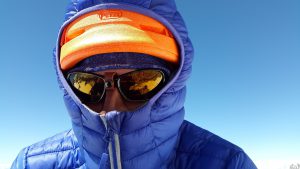It’s official: it’s cold out there. But that doesn’t mean that you have to head to a gym or give up on exercise completely. If you’re feeling up for an invigorating, wintery outdoor exercise session, great! There are definitely benefits to going outside and getting your sweat on when the mercury drops. For one thing, there’s no heat and humidity to deal with, meaning you might be able to work out longer. You’ll also burn more calories, not only from being able to work out longer, but because your body will need to work harder to keep warm. Add to that the boost to your vitamin D levels, as well as the boost to your immune system during cold and flu season, and you’ve got lots of reasons to work up a sweat outside this winter. But before you get out there, check out our tips for staying safe outside no matter the weather.
How Cold Is Too Cold?
Getting out in the fresh air is generally a good idea, but before you head out, be sure to check the weather forecast. Remember to take into account the moisture levels outside, as well as the wind chill factor, Wind chill extremes can make it unsafe to spend long periods of time outside, especially if you’re sweating or have exposed skin. The wind can penetrate your clothing and remove the insulating layer of warm air surrounding your body, and moisture in the air can lower your core body temperature.
So when does the double whammy of cold and wind chill mean you should skip the outside exercise? Well, consider the chances of frostbite in the following temperatures:
- The risk of frostbite is less than 5% when the air temperature is above 5°F (minus 15°C), but the risk rises as the wind chill falls.
- At wind chill levels below minus 18°F (minus 28°C), frostbite can occur on exposed skin in 30 minutes or less.
- If the temperature dips below zero °F (minus 18°C) or the wind chill is extreme, consider taking a break or choosing an indoor exercise instead, especially if it is also wet outside and you don’t have proper waterproof gear.
You should also know the signs of both frostbite and hypothermia if you are going to spend time outside in more extreme temperatures. When in comes to frostbite, it usually occurs on exposed areas like cheeks, you nose, or your fingers or toes, so be on the lookout for the following sensations in those parts:
- Numbness
- Loss of feeling
- Stinging sensation
Hypothermia is an abnormally low body temperature, and you’re at risk for it if you spend prolonged periods outside in very cold – and especially wet – weather. If you experience any of the following signs/symptoms of hypothermia, seek medical attention:
- Intense shivering
- Slurred speech
- Loss of coordination
- Fatigue
One way to protect yourself from the wind chill? Go against the wind first, so when you’re tired and sweaty at the end of your workout, the wind will be at your back and you’ll fight less wind chill.
Dress Smart

While there are times when you should be wary of a long workout session outside, in most cases, and in most places, you should be able to enjoy a run, bike, power walk, or hike without much worry. But that doesn’t mean you shouldn’t be as prepared as possible. The first step? Choosing the right clothing and accessories. When gearing up, remember to:
- Dress dry, not just warm: The last thing you want is soggy, clammy clothes sticking to you during your workout and drawing heat out of your body. This is one time when you want to actually skip the natural fibers like cotton and opt for moisture-wicking fabrics like polyester and nylon.
- Layer up, but…Make sure your layers are easy to peel off and store, whether it’s something you can tie around your waist or attach to your backpack, so you don’t get TOO warm.
- Protect your extremities: One of the tricks to keeping the cold at bay is to keep your feet and hands as protected as possible. Choose shoes that are at least water-wicking, if not waterproof, and socks that are ideally a mixture of materials like merino wool and nylon. As long as it’s not too wet or snowy, you can get away with a thin pair of knit gloves to protect your hands. If it’s really chilly out, consider also adding a warm, thick headband or earmuffs, and a scarf or gaiter wrapped around your neck and the lower half of your face.
- Be bright! Darker winter days mean you’ll be harder to see when you’re outside, especially in the evening (it gets dark at 4.30 in some places!), so dress in bright colors, and consider adding a reflective vest or a headlamp to your list of gear.
- Keep your footing: Just as you would check your tires to make sure their tread isn’t worn down, check your running shoes to make sure that they’ve still got grip!
Safety First
As we already mentioned, you should always take your workout inside if you start shivering or if your extremities start to feel too cold; we’ll also add to that list, if you’re breathing becomes labored or you can’t catch your breath. You also need to dress smartly so you can stay dry and warm, as well as be seen. But there are other things you need to do to stay safe when heading outside for a wintery workout:
- Always bring your mobile phone with you
- Let someone know where you will be and when you will be back
- Wear sunscreen on your face
- Don’t skip your warm-up or cooldown: Your body will need time to adjust to the cold and then readjust to a resting state, so give it that time! Try a dynamic warm-up, including some light cardio and joint mobilization. For example, you can do 3 rounds of high knees (for one minute), 20 side to side lunges, and 20 jumping jacks. When your workout is over, do some static stretching, and then immediately change out of those sweaty clothes!
Hydration Isn’t Just for Hot Weather

What’s one thing you’d never forget to do when exercising in the heat? Drink water! It’s hard to forget about staying hydrated when you’re hot and sweaty in the sun, but it can be easy to leave the water bottle at home when it’s cold outside. But winter is the one time when you should forgo the old, “drink when you’re thirsty, don’t when you’re not” rule; you may not feel much like guzzling a cold beverage when it’s chilly out, but you can still get dehydrated no matter the temperature.
Find what that will keep you drinking, whether it’s playing around with the temperature of your water to find what’s most palatable to you, adding a flavoring to your water, or even switching to a sports drink (although water is always a better choice than sweetened or artificially flavored beverages). If you really can’t bring yourself to drink during your workout, then make sure to drink enough before and after – approximately 20 ounces should be enough. If you plan on working out for more than 90 minutes, though, your best bet is to keep drinking throughout.
Your couch may be calling when the cold weather sets in, but there’s no reason not to keep moving in winter! If you’re bored of doing burpees in your living room, or running up and down your stairs, invigorate your workout and your body with a change of scenery and a brisk outdoor workout. Just remember to dress right, listen to your body, stay hydrated, warm up and cool down – and remember that your couch, throw blanket, and hot drink will be waiting for you when you get back!
